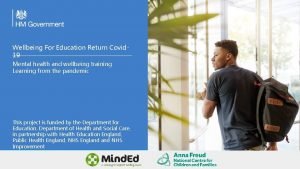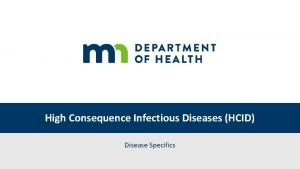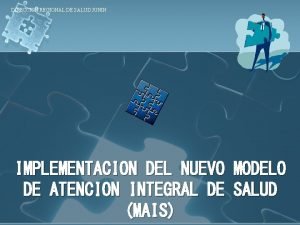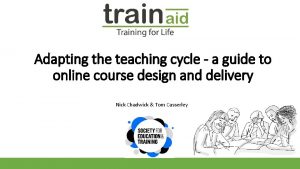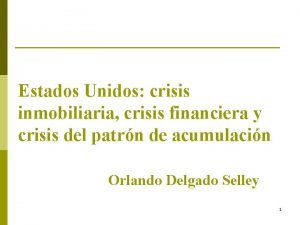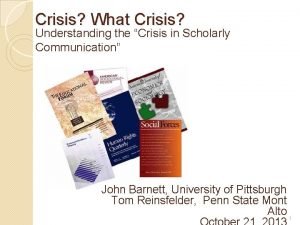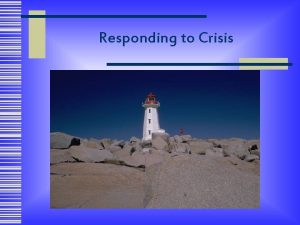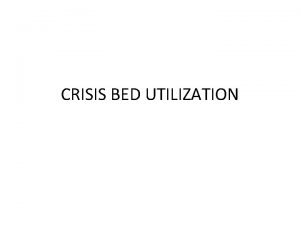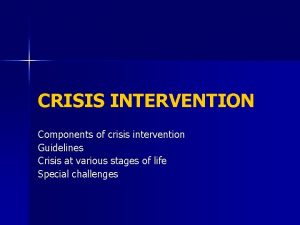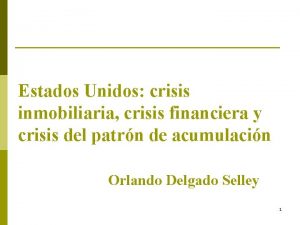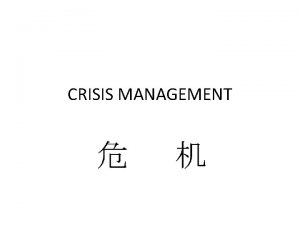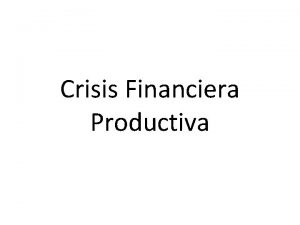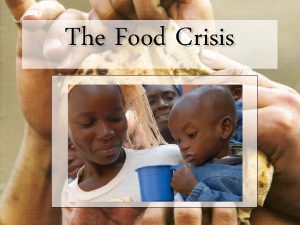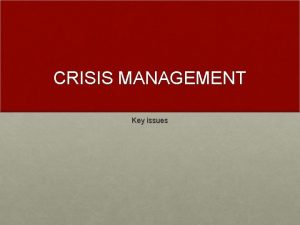CHALLENGES AND OPPORTUNITIES OF THE COVID 19 CRISIS


















- Slides: 18

CHALLENGES AND OPPORTUNITIES OF THE COVID 19 CRISIS FOR TERTIARY EDUCATION 1

Our Vision for Tertiary education SOCIETY INDIVIDUAL Better employability Higher wages Higher democratic participation Better health outcomes 2 The World Bank’s Vision A strong contribution of tertiary education to equitable growth, social cohesion and societies with strong democratic foundations as well as to the success and advancement of individual students Human capital and long-term growth Innovation and regional development Social cohesion and well-functioning societies

HOW TO SHAPE 21 ST CENTURY TERTIARY EDUCATION SYSTEMS Ensure stable foundations, including supporting systems that promote resilience 3 Make equity a priority Prepare for demographic shifts Utilise the opportunities provided by the private sector Promote STEAM fields, grounded in a solid general education, to optimize individual and economic outcomes

…WITH A FOCUS ON SYSTEMS Universities and Post-Secondary Colleges Governments EQUITY Technical and vocational education and training (TVET) Adult education 4 RELEVANCE Private sector FLEXIBILITY DIVERSITY Civil society

KEY CHARACTERISTICS OF THE WORLD BANK’S TERTIARY EDUCATION INTERVENTIONS 1 Since 2015, the World Bank has committed more than US$10. 4 billion in tertiary education related interventions 2 Of the total 274 tertiary education interventions, the majority are Analytic & Advisory Activities, followed by lending *Based on Operations Portal Data: Last accessed April 17, 2020 5 3 Education GP leads the majority of Bank project involving tertiary education; 75 projects have cross-GP collaborations 4 The Africa region has the highest number of WB interventions in tertiary education, followed by Europe & Central Asia, and Latin America & Caribbean 5 91% of the lending commitment is IBRD/IDA and almost 83% of it is dedicated to Investment Project Financing (IPF) operations

REGIONAL DISTRIBUTION OF ALL TERTIARY EDUCATION ACTIVITIES The majority of activities are in the Africa region (29%), followed by ECA at 22% (n=61) and LAC at 15% (n=42) Middle East & North Africa East Asia & Pacific 23% East Asia & Pacific 8% 8% South Asia Region Latin America & Caribbean 15% Africa 12% 29% Other 6% 6 India has the highest number of tertiary education activities (16 total) which includes AAA (50%) and investment projects (44%) Other countries with a high number of TE activities are Vietnam (8); and 7 activities each in Colombia, Kenya, Nigeria, and the Russian Federation

Our Vision for internationalization Tertiary Education Internationalization is a commitment, confirmed through action, to infuse international and comparative perspectives throughout the teaching, research, and service missions of higher education. 7 World Bank

Comprehensive internationalization • Beyond mobility, particularly now that it is almost impossible • Beyond the international office but it needs to play a key leadership role • Leadership to drive internationalizing: • The on-campus curriculum and learning • Research and scholarship • All institutional missions • Global institutional partnerships • As much diversity in practice and approach as homogeneity 8 World Bank

What to do? • Establishing a Strategic Plan for Internationalization • Mission, Vision, Goals • Activities • Evaluation • Defining adequate organizational structure • The key role of partnerships and engagement • Incentives 9 World Bank

COVID 19 Challenges 10 World Bank

IMPACT As of April 6, 2020, universities and other tertiary education institutions were closed in 170 countries and communities, and more than 220 million post-secondary students— 13% of the total number of students affected globally—have already had their studies ended or significantly disrupted due to COVID-19 11 World Bank

IMMEDIATE CHALLENGES Student Loan Maintenance 12 Broadscale Institutional Disruption Staff and Student Illnesses Staff and Faculty Furloughs Curtailing International Mobility Maintaining Instructional Operations Mass Student Displacements Outdated Technology Platforms World Bank Maintaining or Closing Research Operations Equity Implications

IMMEDIATE ACTIONS/CONSIDERATIONS Institutional Closures Course Delivery Recognizing the need for just-in-time support in the day-to-day adaptation of tertiary education delivery to the impact of the pandemic, a series of actions and considerations are which institutions can follow for the immediate and long-term adaptation to the changed environment for tertiary education Many universities and colleges have moved their operations online by taking major actions due to previous investments in digital connectivity. 13 Research (where relevant) Preparing for the next academic year Maintaining organizational operations

Technology bottlenecks to anticipate Inequality in Connectivity Students (and faculty) do not have enough connectivity and devices at home, and this is applies particularly in the most remote areas and among the poorest. The digital divide remains strong, between and within countries Faculty are often underprepared to deploy content. While most faculty Academic staff capacity to deliver members are active online, many have not taught in online mode before remote courses this crisis. While there is a lot of material online, there is little 24/7 Students’ capacity to adapt Platforms 14 technical and pedagogical support available Many, if not most, students are not experienced as online learners. While they may be quick to adapt, students face challenges that lead to dissatisfaction with their academic experience Most universities have not been able to adapt the course content, nor have access to appropriate e-learning platforms. Remote learning is the model used at most universities using non-interactive platforms such as Zoom, Google Meet, etc. whereby the course is delivered through web conferences, emails, and chat groups. Mistakes In an emergency, we need to learn by doing, but we also need to make sure that we can minimize their impact and correct mistakes as they are identified Regulation The regulatory environment is not (yet) aligned to online learning. A key issue is the competitiveness of the Telecoms market, which often favor a monopoly, and does not provide cheap options that work for the poor

Other issues within international HE • Prospective students have been unable to take examinations • International students have been unable to travel to their campuses or to return home • Study abroad programs have been cancelled • Faculty members have been asked not to travel to affected countries – or to avoid foreign travel entirely • Decrease in mobility: restructuring of mobility patterns • Seek financial alternatives: dependency on income from international students will decrease 15 World Bank

But the crisis also offers LT opportunities 16 World Bank

LT Opportunities 2 1 17 Progress on regulation related to e-learning Better/Lower cost inception - students learning remotely, with a chance to go abroad if and when circumstances allow (example: ERASMUS mobility programs) 3 4 Internationalization begins at home: • • Pervasive international engagement through curricular integration as well as active faculty engagement Integrate global perspectives within the programs, and enriching the quality of study program Integrate elements of internationalization into the compulsory program Include virtual mobility through online working with partner universities World Bank 6 Shared online platforms 5 Accelerate staff and student preparedness for online learning Allowing cross registration at other universities, and recognizing courses/credits

THANK YOU! Kamel Braham kbraham@worldbank. org Hana Addam Ghali helghali@worldbank. org With credit to Nina Arnhold and Roberta Basset, Global WB Leads for Tertiary Education 18
 What is the opportunities of informational
What is the opportunities of informational Greater bay area opportunities and challenges
Greater bay area opportunities and challenges Cholinergic crisis
Cholinergic crisis Orticaria dermografica e vaccino covid
Orticaria dermografica e vaccino covid Enregistrement e16
Enregistrement e16 Covid
Covid Thurston county covid
Thurston county covid Grieve everything we covid
Grieve everything we covid C.d.c. covid isolation health workers
C.d.c. covid isolation health workers How we covid
How we covid Covid isolation health workers
Covid isolation health workers C.d.c. covid isolation health workers
C.d.c. covid isolation health workers John hopkins university covid 19 map
John hopkins university covid 19 map Paquetes de atencion integral
Paquetes de atencion integral Covid isolation health workers
Covid isolation health workers Covid 19 pandemic summary
Covid 19 pandemic summary Covid test results detected
Covid test results detected We lost covid
We lost covid The covid cycle
The covid cycle







